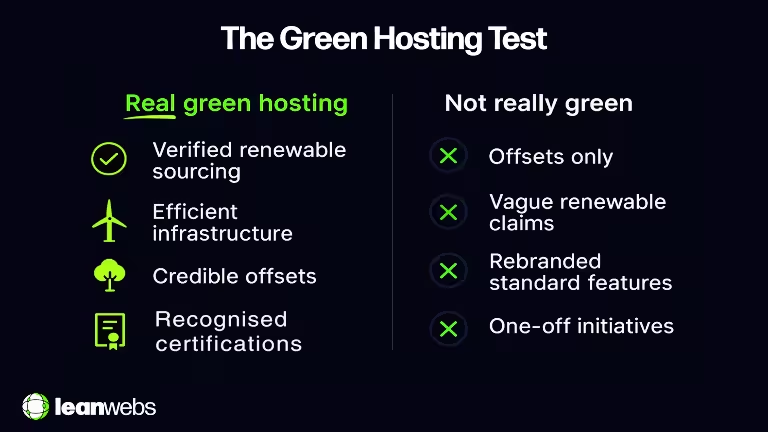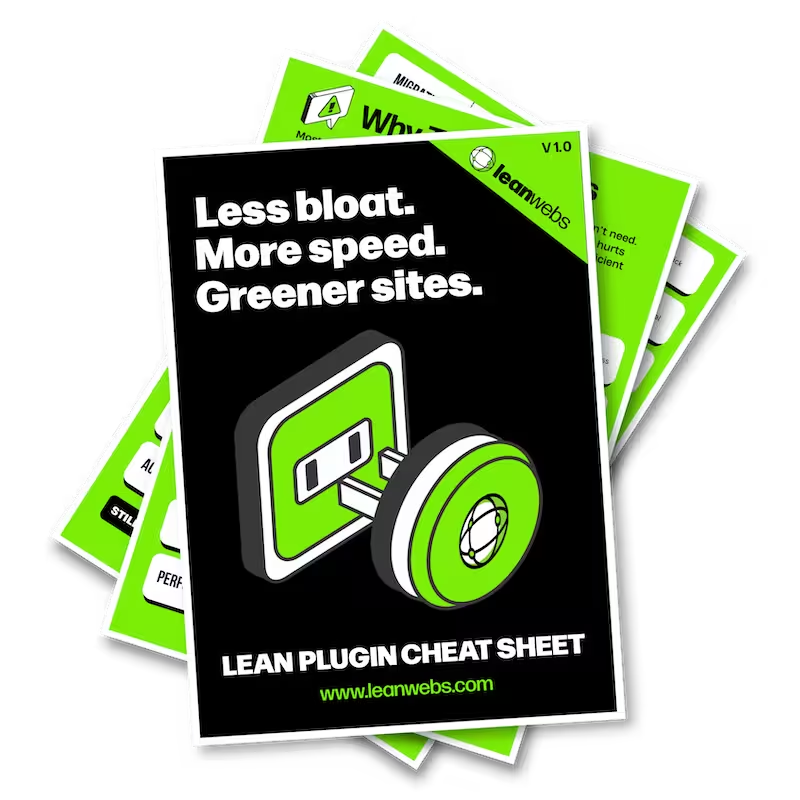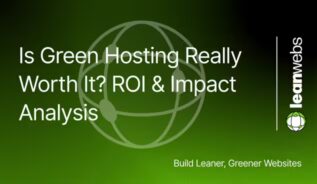Green hosting can cut your site’s carbon impact and boost performance, but only if the provider’s claims hold up. This guide shows you the real criteria that make hosting sustainable, how to spot greenwashing, and which advanced strategies set the leaders apart.
Table of Contents
What “green” really means in web hosting
At its core, green hosting means running the servers that power your site with the lowest possible environmental footprint. That goes beyond planting trees or buying certificates – it’s about clean energy, efficient infrastructure, and low-carbon operations.
Key elements include:
- Renewable energy sourcing – Hosting powered primarily by wind, solar, or hydro instead of fossil fuels.
- Energy-efficient infrastructure – Modern servers, low-energy cooling, and virtualisation to serve more sites with less power.
- Lower emissions per request – Optimising so that each page load uses fewer watts and emits less CO₂, as shown in digital emissions estimates for websites (Sustainable Web Design).
The essential building blocks of a sustainable host
To be more than a marketing claim, a “green” host should be able to demonstrate several core practices, and back them with evidence.
1. Verified renewable sourcing
- Direct purchase of renewable power or on-site generation, ideally from renewable energy sources like wind, solar, and hydro.
- Use of Renewable Energy Certificates (RECs) or Guarantees of Origin to prove the electricity’s source.
- Example: A Nordic provider running data centres on 100% nearby wind farms.
2. Efficient hardware and cooling
- Newer, high compute-per-watt servers.
- Cooling strategies like ambient air or liquid cooling that use far less power than traditional air conditioning.
- Virtualisation to consolidate workloads.
Look for best-in-class Power Usage Effectiveness (PUE) scores – top-performing data centres operate at 1.2 or below.
3. Carbon offsetting with integrity
- Verified, measurable projects such as reforestation or methane capture.
- Offsets as a complement to, not a replacement for, energy efficiency.
The most credible offsets are third-party verified carbon offset projects with measurable, permanent impact.
4. Recognised certifications
- Standards like ISO 14001 or the EU Code of Conduct for Data Centres.
- Third-party verification for credibility.
Energy efficiency isn’t just an environmental win – it can also improve site speed.
What hosting providers call “green”, but isn’t
Not every eco claim holds up under scrutiny. If a provider ticks one or more of these boxes, dig deeper before signing up:
- Offsets without action – Relying solely on tree-planting or carbon credits without reducing actual energy use.
- Vague renewable claims – “100% renewable” with no proof, dates, or independent verification.
- Rebranding standard features – Marketing common practices like virtualisation or SSD storage as uniquely “green”.
- One-off tokenism – Sponsoring an environmental cause once a year while daily operations still rely on fossil fuels.
- No proof or reporting – Missing energy mix data, PUE scores, or independent sustainability audits.
A genuinely green host can back up every claim with hard data: energy reports, independent audits, and clear sustainability roadmaps. For more examples of marketing spin versus reality, see our guide on green hosting myths and greenwashing.

Going beyond the basics: advanced green hosting strategies
The most forward-thinking providers are looking beyond today’s best practices.
- Carbon-aware load scheduling – Shifting workloads to data centres in regions where renewable energy is currently abundant, using real-time carbon intensity data.
- Per-page CO₂ metrics – Showing customers how many grams of CO₂ each page view produces.
- Transparent emissions reporting – Annual disclosures of total energy use, carbon intensity, and renewable mix.
A handful of leading hosts are already testing these advanced methods in real-world conditions, proving that carbon-aware infrastructure can deliver both sustainability gains and strong performance.
Choosing your best-fit provider (and where to start)
When you’re ready to move to a greener host, you’ll want a balance of sustainability, speed, and reliability.
Questions to ask:
- What percentage of your power is from renewables?
- Do you hold any independent sustainability certifications?
- How often do you publish energy and emissions reports?
- What efficiency upgrades have you made in the last three years?
If you’re weighing the environmental and financial trade-offs, see whether green hosting is worth it for ROI, speed, and CO₂ savings backed by real-world data.
Outdated Site? Let's Rebuild It Right
We design and develop fast, sustainable websites with purpose built in. No bloat. No shortcuts. Clean, future-friendly builds made to last.
Next steps
Choosing a truly green host means looking past the marketing and asking for the hard evidence, renewable sourcing, efficiency upgrades, credible offsets, and transparent reporting. The providers that meet these standards don’t just help the planet; they often deliver faster, more reliable websites too.
Check your current host against the criteria in this guide. If they fall short, shortlist providers that meet these standards and make the switch with confidence. For a broader view of how hosting fits into a low-carbon web, explore our guide on what is sustainable web design and why it matters.



